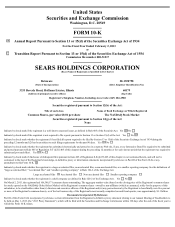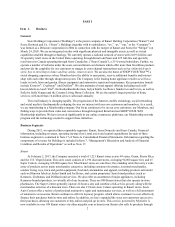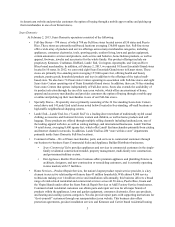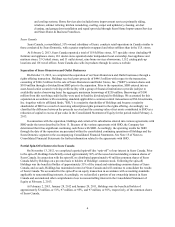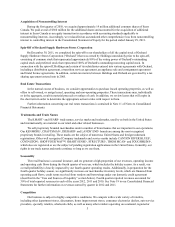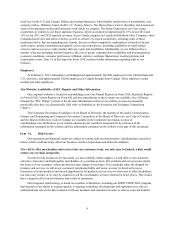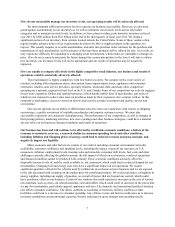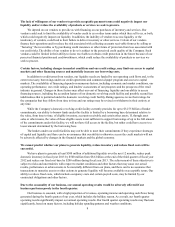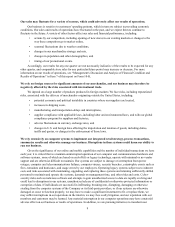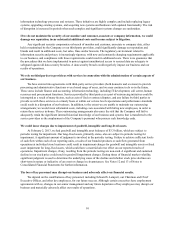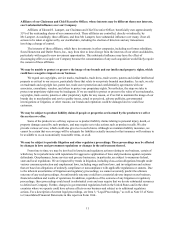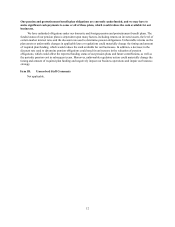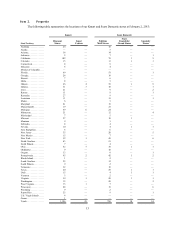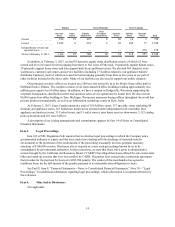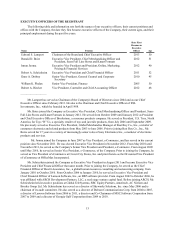Sears 2012 Annual Report Download - page 7
Download and view the complete annual report
Please find page 7 of the 2012 Sears annual report below. You can navigate through the pages in the report by either clicking on the pages listed below, or by using the keyword search tool below to find specific information within the annual report.7
If we do not successfully manage our inventory levels, our operating results will be adversely affected.
We must maintain sufficient inventory levels to operate our business successfully. However, we also must
guard against accumulating excess inventory as we seek to minimize out-of-stock levels across all product
categories and to maintain in-stock levels. In addition, we have plans to reduce peak domestic inventory in fiscal
year 2013 by $500 million from $8.6 billion at the end of the third quarter of fiscal year 2012. We obtain a
significant portion of our inventory from vendors located outside the United States. Some of these vendors often
require lengthy advance notice of our requirements in order to be able to supply products in the quantities we
request. This usually requires us to order merchandise, and enter into purchase order contracts for the purchase and
manufacture of such merchandise, well in advance of the time these products will be offered for sale. As a result, we
may experience difficulty in responding to a changing retail environment, which makes us vulnerable to changes in
price. If we do not accurately anticipate the future demand for a particular product or the time it will take to obtain
new inventory, our inventory levels will not be appropriate and our results of operations may be negatively
impacted.
If we are unable to compete effectively in the highly competitive retail industry, our business and results of
operations could be materially adversely affected.
The retail industry is highly competitive with few barriers to entry. We compete with a wide variety of
retailers, including other department stores, discounters, home improvement stores, appliances and consumer
electronics retailers, auto service providers, specialty retailers, wholesale clubs and many other competitors
operating on a national, regional or local level in the U.S. and Canada. Some of our competitors are actively engaged
in new store expansion. Online and catalog businesses, which handle similar lines of merchandise, and some of
which are not required to collect sales taxes on purchases made by their customers, also compete with us. In this
competitive marketplace, success is based on factors such as price, product assortment and quality, service and
convenience.
Our success depends on our ability to differentiate ourselves from our competitors with respect to shopping
convenience, a quality assortment of available merchandise and superior customer service. We must also
successfully respond to our customers' changing tastes. The performance of our competitors, as well as changes in
their pricing policies, marketing activities, new store openings and other business strategies, could have a material
adverse effect on our business, financial condition and results of operations.
Our business has been and will continue to be affected by worldwide economic conditions; a failure of the
economy to sustain its recovery, a renewed decline in consumer-spending levels and other conditions,
including inflation and changing prices of energy, could lead to reduced revenues and gross margins, and
negatively impact our liquidity.
Many economic and other factors are outside of our control, including consumer and commercial credit
availability, consumer confidence and spending levels, including the impact of payroll tax increases on U.S.
consumers, inflation, employment levels, housing sales and remodels, consumer debt levels, fuel costs and other
challenges currently affecting the global economy, the full impact of which on our business, results of operations
and financial condition cannot be predicted with certainty. These economic conditions adversely affect the
disposable income levels of, and the credit available to, our customers, which could lead to reduced demand for our
merchandise. Changing fuel and energy costs may have a significant impact on our operations. We require
significant quantities of fuel for the vehicles used by technicians in our home services business and we are exposed
to the risk associated with variations in the market price for petroleum products. We could experience a disruption in
energy supplies, including our supply of gasoline, as a result of factors that are beyond our control, which could
have an adverse effect on our business. Certain of our vendors also could experience increases in the cost of various
raw materials, such as cotton, oil-related materials, steel and rubber, which could result in increases in the prices that
we pay for merchandise, particularly apparel, appliances and tires. The domestic and international political situation
also affects consumer confidence. The threat, outbreak or escalation of terrorism, military conflicts or other
hostilities could lead to a decrease in consumer spending. Any of these events and factors could cause us to increase
inventory markdowns and promotional expenses, thereby reducing our gross margins and operating results.

